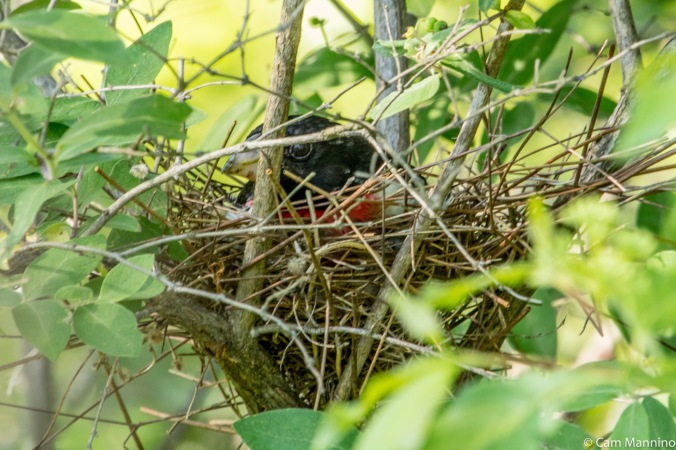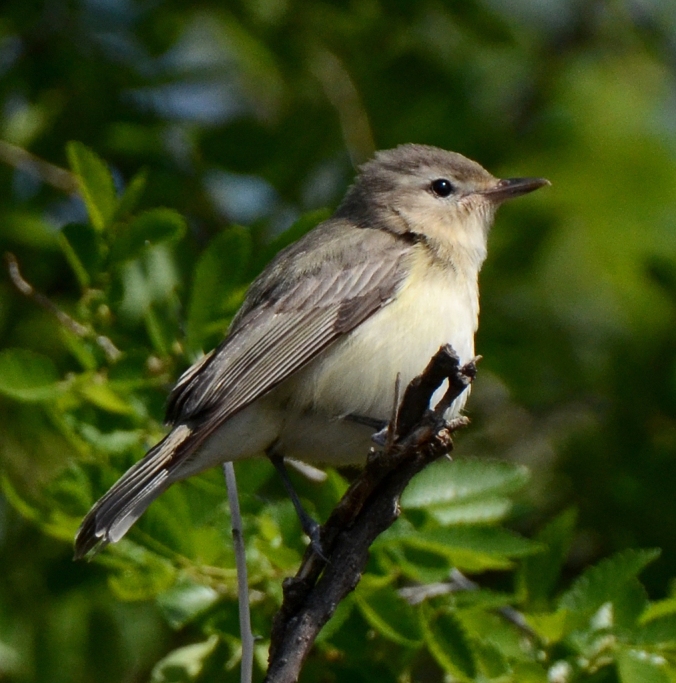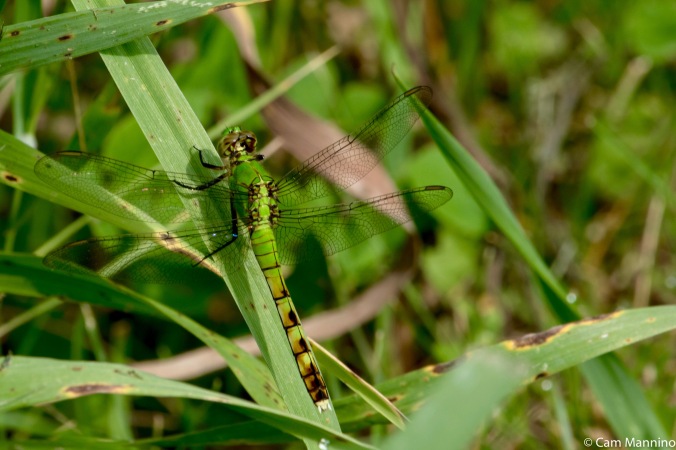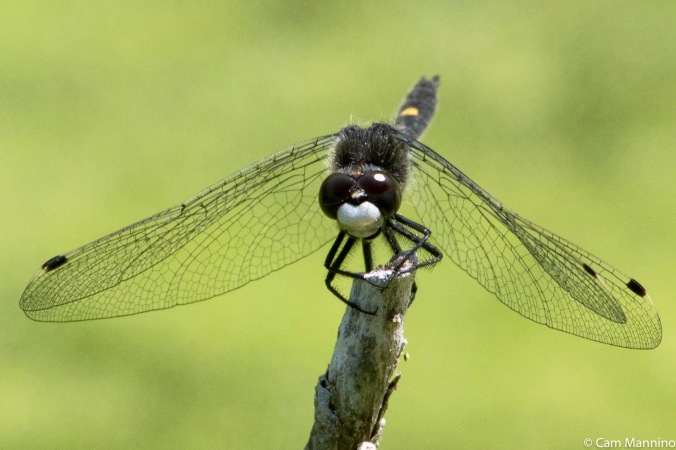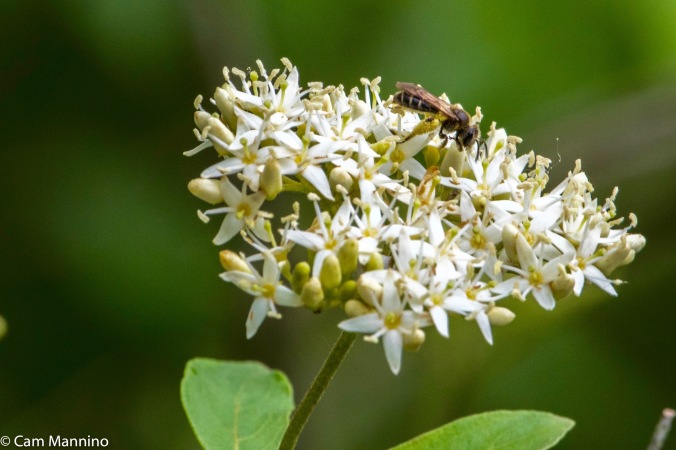The last two weeks at Bear Creek gifted me with some exciting moments – seeing previously unseen birds, witnessing unusual nesting behavior, watching a turtle struggling to bury her eggs and being surprised by a little butterfly I hadn’t seen for years. So though the blog just visited Bear Creek two weeks ago, I wanted to share the bounty I’m enjoying before the season changes much.
Unusual Birds and the Usual Ones Doing Interesting Things!
As many of you know, I’ve been walking in Bear Creek for 25 years and I’ve watched for owls all that time. They spend their days sleeping right next to tree trunks on high limbs, and despite craning my neck for years, I’d never spotted one. But on the first June bird walk, a fellow birder, Bob Bonin, spotted one high up in a tree near Bear Creek Marsh. Huge, silhouetted against the morning sky, this Great Horned Owl (Bubo virginianus) wasn’t easy to see, much less photograph. But luckily, I got a few shots before he gave the group an annoyed look, lifted his huge body with his massive wings and flew away. Such a thrill! (Click on arrows for slideshow; use pause button for a closer look.)
A bit earlier that morning, we saw an unusual bird at the other end of the size spectrum. A male Ruby-throated Hummingbird (Archilochus colubris) perched high on a snag behind the Center Pond and turned his iridescent green back to the morning sun. We saw a quick orange flash at his throat but I missed it. The Stokes Guide to Bird Behavior (Vol. I) indicates that males’ throats look brown or black if the light doesn’t hit their necks just right. When I returned on a late afternoon, there he was on the same snag – but this time the afternoon sun caught the edge of his throat which shone gold rather than ruby red. He’s not the most glamorous hummer, but I’m glad I got to see a bit of his gleam.
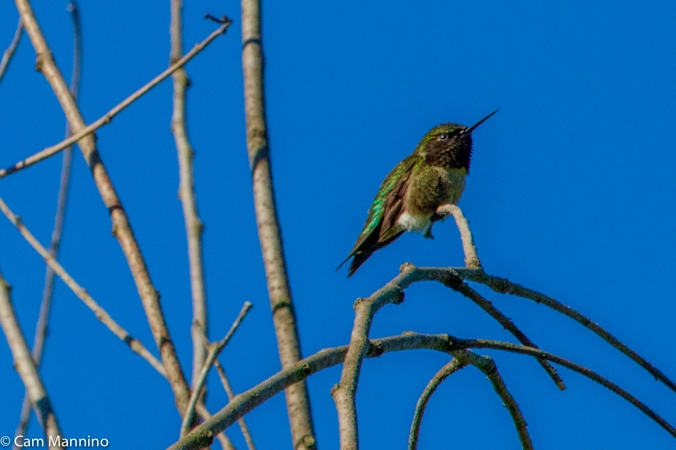
This male hummingbird’s bright throat only shone for a second in the morning sun, so I settled for the light in his eye and his iridescent green back.
Near the Center Pond, the birders also discovered the nest of a Rose-breasted Grosbeak (Pheucticus ludovicianus) – with the male sitting calmly, tending the eggs or nestlings. Occasionally, he even sang his lovely tune as he waited patiently. I’d read in the Stokes Guides that male Grosbeaks sometime take on this responsibility, but I’d never seen it. On three separate visits, the male was the only one on this nest – though the female may have relieved him at other times. So, Happy Father’s Day to this dedicated Grosbeak dad!
In a willow to the right of the deck in the Center Pond is a beautiful nest. It’s cleverly attached between two vertical branches about 20 feet up, ingeniously woven and quite large – maybe 9 inches long. During my first 3 visits, only the female’s black tail cocked behind her was visible from the observation deck. Finally one afternoon, I waded into the grass at the pond’s edge and caught sight of her hindquarters as she fed her young. And then, I saw a fledgling’s head just above the edge of the nest. Ah, this nest was constructed by a female Red-winged Blackbird (Agelaius phoeniceus) – a somewhat eccentric one since Red-wings normally build close to the water and weave their nests among cat-tails or reeds. She’s quite an architect! The location of this elaborate nest makes it nearly invisible and unreachable by predators. Clever mama Red-wing!
Two nests appeared high in a tree on the Walnut Lane. The barely visible, masked eye of the female Cedar Waxwing (Bombycilla cedrorum) peeked through the leaves that camouflaged the first nest spotted by the birders. Since she sat there quietly every time I visited, I’ve included a photo of a Waxwing from a previous year so you’ll remember how elegant this conscientious mother bird truly is!
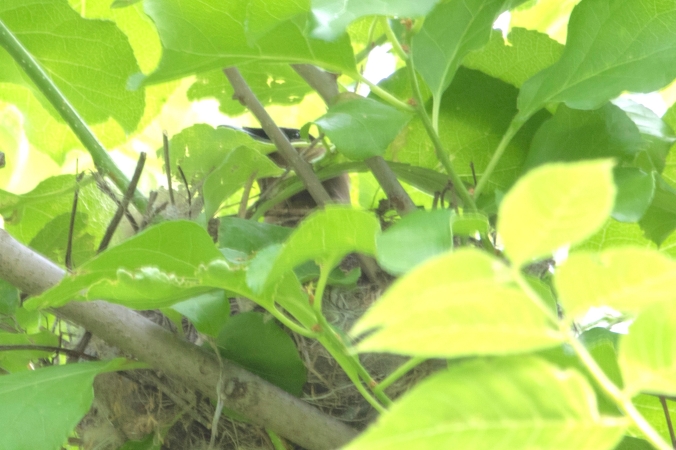
Only the masked eye of the female Cedar Waxwing shows above the edge of her cleverly hidden nest along the Walnut Lane.
Across the Walnut Lane, the birders also discovered the nest of a female Eastern Kingbird (Tyrannus tyrannus) who spent several days building her gauzy, somewhat more loosely constructed nest. She proudly stood above it a few days later as it neared completion. The female Kingbird constructs the nest and keeps the male off it until the eggs hatch. Then both parents feed the nestlings. But even during the egg phase, the male stays on a branch nearby to defend the territory for his mate and young.
Another good provider, a tiny male Yellow Warbler (Setophaga petechia) brought a bright green caterpillar to feed his nestlings or mate. In between feeding trips, he’d let loose with his proud song, “Sweet, sweet, I’m a little sweet.” Impressive dad who can bring home the bugs, singing all the while! Bet the female warbler was as impressed as I was.
An Orchard Oriole male (Icterus spurius) serenaded us from a small tree in the middle of a meadow. His long, melodious song sounded much like the third song recorded at this link. A few Orchard Orioles seem to come to Bear Creek each year – but they migrate south by mid-July. So keep an eye out and an ear cocked soon in the meadows to the east of the Walnut Lane!

A male Orchard Oriole singing with gusto in the meadow beneath the seating area in the southern end of the park
An invisible bird, high up in the tree tops, repeated its melodious warble continuously one warm morning. I’ve never seen a Warbling Vireo (Vireo gilvus); they rarely come down from the heights. But fortunately, a great photographer from the iNaturalist website, Steven Mlodinow, has seen one and generously allows others to borrow his photo. Listen for this warbler’s rich melody all summer long, but don’t be surprised if you never spot this elusive summer resident.
Little Surprises Near the Wetlands
At the northeast corner of the Center Pond, a young Painted Turtle (Chrysemys picta) hurried to cover her eggs one hot afternoon. She’s found a likely spot where Ben had cleared away invasive shrubs a couple of years ago. As you’ll see in the video below, she work really hard with her back legs to get the dirt to move. She’d no doubt have preferred sandier soil! But she was determined to see the job done!
I’ve seen Northern Leopard Frogs (Lithobates pipiens) periodically at Cranberry Lake but never one at Bear Creek. But hearing their snoring call near a wetland, I waded into tall grass and found this one, hiding among the greenery. Glad to know this beautiful frog is at Bear Creek, too.
Ben noticed an Eastern American Toad (Anaxyrus americanus) toad on the path one afternoon when we went to look at nests. Normally, I only see brown toads, but Wikipedia informs me that “The color and pattern is somewhat variable, especially for the females. Skin color can change depending on habitat colors, humidity, stress, and temperature…Some toads of this subspecies have a more pervasive red and deep brown color, many with red warts on their bodies.” So this little toad is probably female and the red description fits her pretty well. I wonder if the unusually hot temperatures had an effect on her appearance? Hard to tell.
Amazing Insects: A Butterfly I’ve Missed for Years, Favorite Dragonflies and the Skills of Tiny Pollinators
Next year, I’ll be looking for the boldly patterned Baltimore Checkerspot butterflies (Euphydryas phaeton) on June 11 or 12. I’ve only seen them on those two dates, 6 years apart! This year, four of them fluttered at a spot in the trail where water runs under the path – a place I’ve often seen other small butterflies feeding on minerals left by the water. Later in the summer, watch for the communal caterpillar webs of these small butterflies (about 2.5 inches) on the host wildflower Turtlehead (Chelone glabra) where these butterflies lay their eggs during the summer and where the caterpillars first feed.
Interestingly, in the fall, Baltimore Checkerspot caterpillars wrap themselves in leaf litter, overwinter and finish developing in the spring. This seems to be a big year for them – so keep an eye out if you see a small, dark butterfly at your feet.
Different species of dragonflies seem to appear each week to dance among the budding wildflowers and over the pond. The dramatic, yet quite common Twelve-spotted Skimmer (Libellula pulchella) did indeed skim over the tops of grasses in the Eastern Meadow this week. Dragonflies often land, fly, and then come back to the same dry stalk – so if you miss one in your binoculars the first time, wait a moment and you’ll probably see it in the same place again!
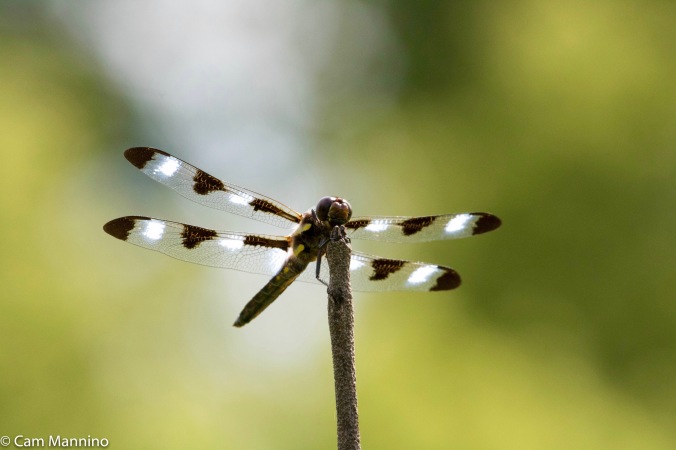
A bright green Eastern Pondhawk (Erythemis simplicicollis) dragonfly clung to a grass stem on the western slope. If it’s a male, it will gradually turn blue over the summer. If a female, it will remain green. Probably this one is newly emerged since it’s hunting in a meadow. When it’s ready to mate, it will rendezvous with others at the Center Pond.
A small Dot-tailed Whiteface (Leucorrhinia intacta) dragonfly posed for a face-on selfie at the Playground Pond before continuing its quest to consume as many mosquitoes, flies and other small insects as possible before the day is out. Love its cartoon-like face and the one yellow dot on its tail that give it its name.
Pollinators are busy all over the park, feeding and carrying the pollen that will bring us next year’s blooms. This may look like a European Honey Bee (Apis mellifera) but Honey Bees are fuzzy all over and this one just isn’t. So it’s more likely to be a Dronefly (Eristalis tenax), a type of Hoverfly (family Syrphidae), which uses its pattern, slight fuzziness and loud hum to mimic male Honey Bees as a way of protecting against predators. Droneflies cannot sting, but a passing dragonfly probably doesn’t take a chance!
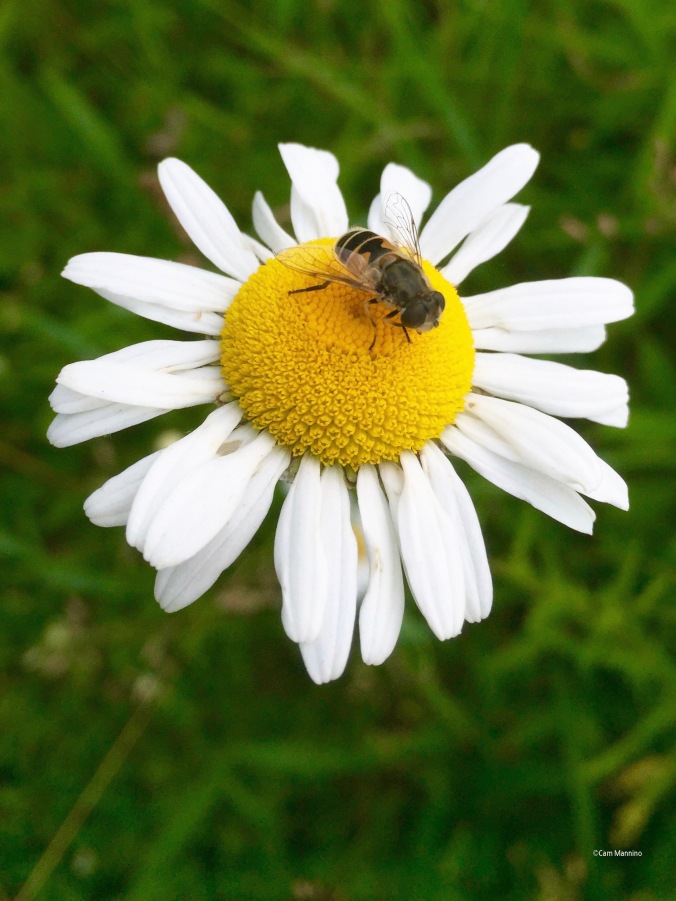
This dronefly (a kind of hoverfly) mimicks a bee’s appearance and hum for protection.
I noticed what looked at first like a tiny wasp on this umbel of a native Nannyberry bush (Viburnum lentago) near the Center Pond. But after a bit of research in Pollinators of Native Plants by Heather Holm, I’m going to guess it’s a female Leaf-cutter Bee (family Megachilidae). It has a wasp-y pattern and shape and it’s collecting pollen on its abdomen and on the top of its back leg (look at those jodhpurs!). Leaf-cutters cut small, neat circles out of leaves, hence the name. They then roll up a single fertilized egg and a chunk of pollen in each circle, forming a solitary, cigar-shaped nest which is placed in a hole in the soil, wood or other structures. Such an unusual nest!
Bring a Friend – or Friends! – to Visit Your Favorite Park

Oakland Township Natural Areas manager Ben VanderWeide leads a group of birders at Cranberry Lake Park
I’ve always loved walking alone in the township parks. I can listen to birdsong, stop to look at something tiny like the Little Wood Satyr butterfly below, or enjoy the fresh scents of wood, greenery, the earth after a rain in silence. Solitary walks are contemplative.
But this particular blog testifies to the special pleasures of hiking with interested friends and family. First of all, they just bring more eyes! I’m always seeing things with the birders or with my husband, that I’d never have noticed with just my two eyes (in this case, the owl, the hummer, the oriole, the male grosbeak in his nest and more). But also their curiosity piques mine. They bring specialized interests and knowledge. They often patiently help me find the bird hiding in a leafy tree (“The center trunk at about 2 o’clock…). It’s a different kind of delight to walk with nature-noticing friends. So if all of this nature stuff intrigues you, take some nature-lovers with you on your next walk. Or consider joining our friendly birding group on Wednesday mornings year ’round. We’d love to have you join us! (The schedule is under “Events” at the top of the home page.)
Footnote: My sources for information, besides Oakland Township's Stewardship Manager Ben VanderWeide, are as follows: Pollinators of Native Plants by Heather Holm; Stokes Nature Guides: A Guide to Bird Behavior Volumes 1-3; Allaboutbirds.org, the website of the Cornell Ornithology Lab at Cornell University; Wikipedia; Herbarium of the University of Michigan at michiganflora.net; various Michigan Field Guides by Stan Tekiela; other sites as cited in the text.



